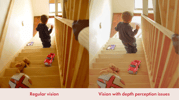
 Written by Dr Miriam Stoppard OBE
Written by Dr Miriam Stoppard OBE
As Stannah’s Health and Wellbeing Advisor, we asked Dr Miriam Stoppard for her advice on Seasonal Affective Disorder (SAD), including the symptoms and treatments.
What is Seasonal Affective Disorder?
We’re all affected by the weather to a certain extent, some of us more than others. It’s natural to feel glum in the dark, cold, wet days of winter and the opposite in the long, warm, light days of summer. But for a few people, the rhythm of the seasons has an exaggerated effect — particularly the sadness of the dark winter months. For some, that time of the year ushers in depression deep enough to affect daily life. Paradoxically, some people experience this kind of depression in summer, when days of bright sunshine can bring it on. This seasonal low mood describes Seasonal Affective Disorder or SAD. Usually SAD develops when an individual is in their mid-20s and women often suffer with SAD more commonly than men.
When does Seasonal Affective Disorder start and what are the symptoms?
It appears that it’s the change in seasons that triggers SAD and it’s particularly likely in countries where the seasons are clearly marked by changes in light and weather. When the clocks go back in the autumn seems to be an especially vulnerable time of year.
SAD isn’t uncommon, so if you feel depressed during a specific season, change of season or particular type of weather you could be suffering from SAD. You may find that your energy slumps, you want to sleep more than usual and you also eat more.
Not only may you sleep longer but you may not want to get up at all. You may also find yourself going to bed in the middle of the morning and earlier and earlier in the evening. In addition, you might notice you feel reclusive which might make you want to just hunker down and not see people.
Your SAD may have the classical symptoms of profound sadness, tearfulness, feelings of unworthiness, hopelessness and engender loss of interest in intimacy and sex; even suicidal thoughts.
You mustn’t suffer these feelings alone but speak to your doctor as soon as you start to feel them. They may pick up on the fact that your feelings of sadness come back at about the same time of year and recognise SAD. Physical ailments you have may tend to get worse during SAD, as do mental health problems.
How will I know I have SAD?
The main feature of SAD is feeling depressed at particular times of year related to specific seasons, summer as well as winter, or during particular kinds of weather.
One of the ways to spot this seasonal depression is to keep a diary, where the pattern will show up. Note down anything that seems to trigger your depressions, the time of year they start and when you begin to feel better and the depression lifts. Things that make your SAD worse like the weather may become obvious.
If you spot a pattern emerging you can begin to plan ahead so that you go easy on yourself as the difficult season approaches. For instance, save your stressful jobs for more undemanding times and practise daily yoga and relaxation exercises. Social interaction is proven to be invaluable for our mental health so visiting friends before SAD approaches can help ease symptoms, as can ensuring you allow yourself to rest for a certain amount of time every day.
Does SAD have a cause?
Not a single or specific one, though the theory goes that diminishing daylight hours in the autumn brings it on and the absence of daylight hours in the dead of winter can make it worse. It appears some people are very sensitive to the amount of light that reaches the brain through the eyes. They need more than average, so their SAD affects the winter months when light levels are low. On the other hand, bright sunshine is difficult for others to cope with and their SAD afflicts the summer months.
Another theory is that the body clock in your brain slows down, making you feel fatigued, sleepy and depressed.
High melatonin levels are seen by some as the culprit. Melatonin is our internal sleep-inducing hormone and appears as darkness falls. Some people with SAD are thought to have higher levels of melatonin than normal — a change, incidentally, that causes animals to hibernate.
It’s not just the differences in light during winter and summer that seems to precipitate SAD. Differences in weather — hot and cold — can also lead to SAD.
What can I do to help myself?
Depending on whether you have winter or summer SAD you should try different approaches. If, for instance, you have winter SAD, go outdoors as often and for as long as you can. When indoors, sit next to a window. Prepare for winter and fill your freezer with meals, soups and puddings.
On the other hand, for summer SAD it’s wise to stay in the shade, wear a wide-brimmed hat and sunglasses and visit museums, art galleries and cinemas when you are able (which are all indoors but, importantly, out of your house). Remember also to drink plenty of water. When times get tough don’t hesitate to phone a friend or helpline (Samaritans 116 123; SANEline 0300 304 7000; Campaign Against Living Miserably (CALM) 0800 58 58 58; The Silver Line 0800 4 70 80 90).
A great suggestion from MIND is to make yourself a “self-care box” filled with mementos that comfort you, help you to think of good times, bring back happy memories and soothe your troubled mind. Include photographs, cards, a favourite book, a CD you love, a video that inspires you, fairy lights and decorations for Christmas. Make a point of learning to relax with relaxation exercises, yoga and spending time in nature. Stress management is worth practising.
Medical treatments
The mainstays of treatment are talk therapies, medication and light therapy and your GP should be the first person you turn to. Talking therapies and counselling can be effective in depression and are worth a trial in SAD. In combination with talk therapy your doctor may suggest taking an antidepressant such as an SSRI (a selective serotonin reuptake inhibitor).
Some people swear by strong white or blue light emitted by a light box but, unfortunately, you can’t get light therapy on the NHS because there isn’t enough proof that it works. I suggest you discuss it with your doctor who can advise if it’s a good idea for you to try and how you should use it.
As a rule, you sit a few feet from the special light box within an hour of waking. This apparently brings about changes in brain chemicals which influence your mood. The effect of light therapy is usually felt in a few days or weeks when symptoms ease. Your doctor will advise you on the frequency you should use the light box and for how long each session should last.
Remember that you’re never alone. Speaking to a friend, family member, doctor or calling a helpline can make a world of difference.
Stay up to date
Latest Blogs

Whole Home Comfort with Stannah and HSL

Dame Zandra Rhodes x Stannah: When accessibility meets style
Could more people benefit from home adaptation support for hidden disabilities?
50 years of Stannah Stairlifts – A milestone grounded in purpose

BBC’s Dr Punam Krishan reveals a little-known Parkinson’s symptom to watch for...

Are you at risk of falling? Dr. Punam Krishan’s simple 12-second test could tell you...

Snore Wars: Could sleeping separately be the secret to a better night’s rest?

Proud to carry the Made in Britain mark!
Stairlifts made for you
All our stairlifts whether straight or curved are customised to suit you and your home so call now to arrange a visit to get your FREE personalised quote!